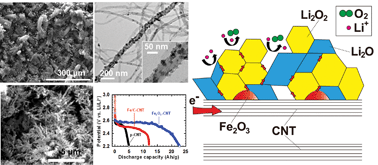Enhanced oxygen reduction and evolution by in situ decoration of hematite nanoparticles on carbon nanotube cathodes for high-capacity nonaqueous lithium–oxygen batteries
Abstract
Lithium–oxygen (Li–O2) batteries are considered to be the next generation energy storage technology due to their extremely high theoretical energy density and the simplicity of the battery cells. However, a large energy density can be obtained only with a slow discharge–charge rate, and quickly decreases upon cycling. These drawbacks can be attributed to the large overpotential and sluggish kinetics of the oxygen reduction and evolution reactions. To overcome the current problems, recent research has focused on developing catalysts made of inexpensive metal oxides and carbonaceous materials in addition to precious metals, but the role of non-precious metal catalysts in the battery performance is still largely unexplored. Here we present kinetic studies and comparative evaluation of enhanced oxygen reduction and evolution reactions with carbon nanotube (CNT) arrays containing in situ decorated α-Fe2O3 nanoparticles as both a binder-free catalyst and a cathode for nonaqueous Li–O2 batteries. Our Fe2O3-decorated CNTs greatly helped to form Li2O involving the four-electron reduction pathway in addition to Li2O2 commonly formed via the one/two-electron reduction pathway, and thereby delivered a very large capacity of 26.5 A h g−1 at the 1st discharge and a relatively long cycling performance (48 cycles with a capacity limit of 1.5 A h g−1). Unique and branch-like nanocrystalline Li2O and Li2O2 after discharge would have lowered the overpotential for the oxygen evolution reaction. Our detailed compositional and morphological studies will be of great help to further improve the cycling performance as well as develop better non-precious metal catalysts and electrodes for Li–O2 batteries.



 Please wait while we load your content...
Please wait while we load your content...